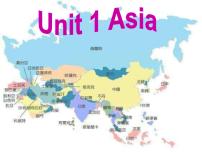







英语九年级下册Unit 1 AsiaWelcome to the unit课文内容课件ppt
展开
这是一份英语九年级下册Unit 1 AsiaWelcome to the unit课文内容课件ppt,共32页。PPT课件主要包含了 情态动词 ,will there,was there,phrases等内容,欢迎下载使用。
Welcme t the unit
Unit 1 Asia
Ww, the Great Wall is amazing , isn’t it ?
N, it isn’t . It’s tiring t climb the steps and my feet hurt. I’m taking a rest.
N, Eddie ! There’s still a lng way t g . We’d better keep mving.
I dn’t want t g n, Hb. Wake me up n yur way back.
Imprtant language pints
反意疑问句是由陈述句和附在其后的附加疑问句组成。其中附加疑问句是对陈述句所说的事实或观点提出疑问,起证实作用,一般用于证实说话者所说的事实或观点。
1. The Great Wall is amazing, isn't it? 长城太神奇了,不是吗?
1.反意疑问句前后两部分谓语应是:“肯定陈述+否定疑问”或“否定陈述+肯定疑问”; (前肯后否,前否后肯)2.简略问句如果是否定式:nt应与be,d,will等系动词、助动词、情态动词缩写; 3.简略问句的主语不用名词,应用人称代词;4 .陈述部分有never, seldm, hardly, few, little等词时,疑问用肯定形式;He has few friends here, des he? She said nthing, did she?
5.There be 句型结构的疑问部分主语用there;There was nthing in the rm, was there?6.祈使句的反意疑问句一般为Let’s-----, shall we ?其它的疑问部分均可以为will yu ?Cme with us, will yu? Dn’t frget t pst the letter, will yu? Let’s g hme, shall we ?
7.主句为I / we think/ believe/ suppse 带宾语从句的复句的疑问部分是主语动词与从句保持一致。He knws where I live, desn’t he?I dn’t think he will cme, will he?8.若陈述部分含有带否定前缀的词,疑问部分仍用否定式;It is unfair, isn’t it? It is impssible, isn’t it? 9.当陈述部分的主语是复合不定代词时,若陈述部分的主语为smebdy, everyne, n ne, 等复合不定代词,其反意疑问句的主语在正式文体中用he,在口语或非正式文体中通常用they,
当陈述部分的主语是smething, nthing, everything等复合不定代词时,其反意疑问句的主语要用it;Nbdy was late, were they/was he/was she?Everything is ready, isn’t it? Nthing is imprtant, is it?10.当陈述部分是I wish…时,疑问部分通常用may I.I wish t g with them, may I?
It’s cld ,___________?
be 动词: 1. Yu are an actr, ________ _____ ? 2. He is a gd by, ________ ______ ? 3. It was fine yesterday, _______ ___ ? 4. Yu were studying when I called yu last night, __________ _____ ? 5. She is ging t visit me, _____ ____?
aren’t yu
isn’t he
wasn’t it
weren’t yu
isn’t she
行为动词: 1. It ften rains here, ________ ___ ? 2. He likes sccer, _________ ____ ? 3. Yu have a headache, _______ ___ ? 4. I called yu yesterday, _______ __?
desn’t it
desn’t he
dn’t yu
didn’t I
1) He can play the pian,_________? 2) He shuld g right nw, __________? 3)They can’t finish it, ___________?
shuldn’t he
特殊用法1---There be句型的反意疑问句。陈述句为There be结构时,附加问句仍用there。
1.There is a famus dctr in yur hmetwn, ______________? Yes, there is. 2.There will nt be any classes tmrrw, _________________? N, there wn’t. 3.There wasn’t anything new n TV last night, _____________? Yes, there was a new TV play. It was very interesting.
isn’t there
特殊用法2---当陈述部分的主语是指示代词this, that或these, thse时,附加疑问句中的主语分别用it和they。This is imprtant, ? That isn’t crrect, ? These are yur friends Tm and Jack, ?
aren’t they
特殊用法3 ---陈述部分有否定意义的词,疑问部分用肯定陈述部分如果有否定意义的词,如:hardly(几乎不), never(从不), nthing, few, little, n, seldm(很少), t…t等, 这时疑问部分要用肯定形式,但含否定前缀的词除外。
1.Mr. Smith can hardly speak Chinese, ________? 2.She has never been t Hng Kng, ___________? 3.There is nthing imprtant in the newspaper, ______________? 4.Few peple eat wild animals nw, __________?5.He knws little German, ____________ ?6.He is t yung t jin the army, ___________?
特殊用法6对反义疑问句的回答回答反意疑问句的问题时,要注意根据事情情况回答.只要事实是肯定的,就用Yes回答,如果事实是否定的,就用N回答.
1. Yu haven’t been t the U. S. , have yu?_______________. I want t have a visit ne day. _______________. I have been there three times.
N, I haven’t.
Yes, I have.
【练习】 (1)There is little juice in the glass, ______? A. is there B. isn’t there C. is it (2)---Yu’re new here, ________? ---Yes, I’m frm Dujiangyan. I came here last week. A. d yu B. dn’t yu C. are yu D. aren’t yu(3) I dn’t think fish can climb trees, ____ ____?
4.Yu used t be utging, ________? A. d yu B. dn’t yu C. didn’t yu D. did yu5.Hundreds f peple lst their lives in the accident,_______ they? A. dn't B. didn't C. d D. did
6. ---Lily didn't cme t schl, did she? ---____. She was ill in bed. A. N, she did B. Yes, she did. C. N, she didn't. D. Yes, she didn't7.---She isn't a teacher, is she? ---_____. She wrks in a hspital. A. N, she is B. Yes, she is. C. N, she isn't. D. Yes, she isn't
2. We'd better keep mving. 我们最好坚持走。 had better d sth 最好做某事 had better nt d had better后接动词的原形我最好在妈妈到家前完成家庭作业。I'd better finish my hmewrk befre mm gets hme. keep ding sth. 坚持做某事,一直做某事e.g. He kept talking until the meeting was ver.他一直在说,直到会议结束。
Language pints:
3. I dn't want t g n. 我不想继续了。 • g n ding sth .指继续做同一件事 如: After a shrt rest , they went n wrking. 短暂休息之后,他们继续工作。 • g n with sth . 指继续同一件事,此时with 后能接名词,代词,不能跟ing 形式。如: After a shrt rest ,they went n with the wrk . • g n t d sth . 指接着做另外一件事。如: After finishing the wrds , they went n t g ver the text. 结束单词后,他们接着通课文。
tiringstepChinese kntChinese peraChinese paper-cuttingchpsticksdragn dance
adj. 使人疲劳的,累人的n. 台阶;梯级n. 中国结n. 中国戏曲n. 中国剪纸n. [复]筷子n. 舞龙
Chinese culture
Dragn dance
Chinese pera
Chinese knt
Chinese paper-cutting
Chinese Kungfu
Chinese knt Chinese kung fu Chinese pera Chinese paper-cutting chpsticks dragn dance
Kevin: I’m planning t travel arund China. Where shall I visit first, Millie?Millie : Since yu’re in Beijing nw. Why dn’t yu start frm here? Tian’anmen Square ,the Palace Museum and the Great Wall are wnderful places t g.Kevin: Gd idea. What special things can I see in Beijing?
Millie :Chinese Opera is a kind f traditinal Chinese art, and Chinese Opera is ne f the mst ppular. Yu can g and enjy it.Kevin: OK. Thank yu fr yur suggestins.Millie : Yu’re welcme.
have/take a rest g n keep mving wake me up n yur way back had better (nt) d
休息一会儿继续坚持走叫醒我在你返回的途中最好(不)做
相关课件
这是一份初中英语牛津译林版九年级下册Unit 1 AsiaWelcome to the unit教学演示课件ppt,共45页。PPT课件主要包含了课文呈现,考点精讲,反意疑问句,考点1,考点2,考点3,考点4,考点5,考点6,考点7等内容,欢迎下载使用。
这是一份英语九年级下册Welcome to the unit教学演示课件ppt,共26页。PPT课件主要包含了couplet 对联,kung fu功夫,Part A,Beijing,Part B,Kevin,Millie,Cindy,You,不到长城非好汉等内容,欢迎下载使用。
这是一份初中英语牛津译林版九年级下册Welcome to the unit课文课件ppt,共31页。PPT课件主要包含了China,HOMEWORK等内容,欢迎下载使用。











